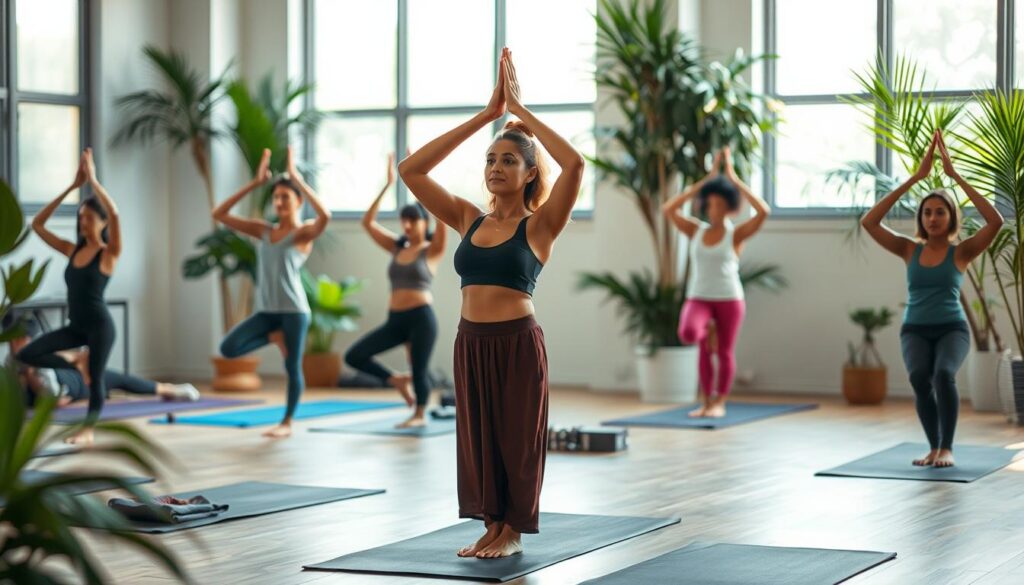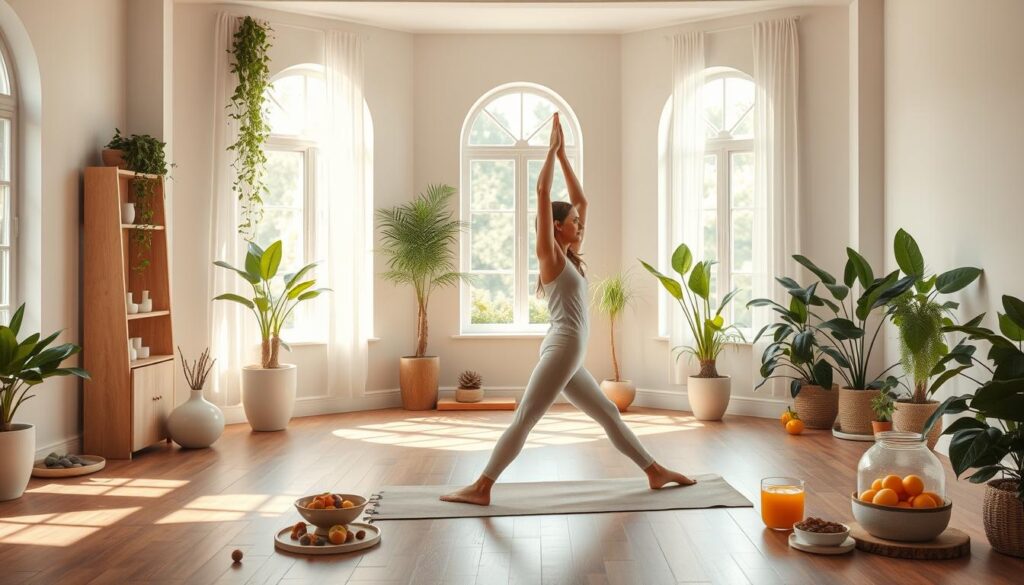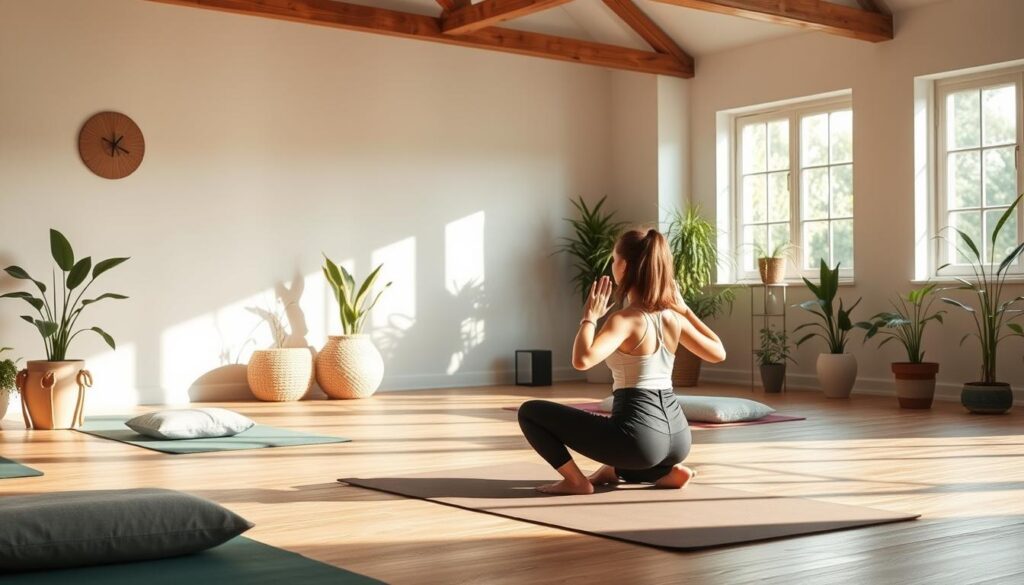high blood pressure yoga or high blood pressure, is a big health problem. It affects nearly half of American adults. The Centers for Disease Control and Prevention says so. If not treated, it can cause heart attacks and strokes.
But, research shows that high blood pressure yoga can help. It’s a natural way to lower your blood pressure.
Studies found that doing yoga three times a week can lower blood pressure. This is more true when you add breathwork and meditation. This mix can help you manage your high blood pressure and feel better overall.
Key Takeaways:
- Nearly half of American adults have hypertension, a common health condition that can lead to serious risks like heart attacks and strokes.
- Practicing yoga three times a week can significantly lower blood pressure compared to those who don’t practice.
- Combining yoga with breathwork and meditation enhances the benefits for high blood pressure management.
- Yoga poses involving controlled breathing can help reduce stress and improve blood circulation.
- Incorporating a variety of yoga poses, including standing, seated, and restorative poses, can provide comprehensive benefits for hypertension control.
Understanding High Blood Pressure and Its Impact on Health
High blood pressure, or hypertension, is when your heart pushes too hard against your blood vessel walls. This can harm your health a lot. Knowing what causes it and how to spot it is key to fighting it.
What Causes Hypertension?
Many things can lead to high blood pressure. Your family history, age, gender, and race play a part. Medical conditions like kidney disease can also raise your blood pressure.
But, most causes are linked to how you live. Not moving enough, eating badly, smoking, drinking too much, and feeling stressed are big culprits.
Risk Factors for High Blood Pressure
- Family history of hypertension
- Advancing age
- Being male
- Belonging to certain racial or ethnic groups
- Overweight or obesity
- Sedentary lifestyle
- High-sodium, high-fat diet
- Excessive alcohol consumption
- Chronic stress and anxiety
Common Symptoms and Warning Signs
High blood pressure often doesn’t show any signs, making it a silent killer. Many people don’t know they have it until it’s very bad. Checking your blood pressure regularly is very important.
“Uncontrolled hypertension is linked to significant health issues, with 62% of cerebrovascular disease and 49% of ischemic heart disease attributed to uncontrolled hypertension.”
If you don’t treat high blood pressure, it can cause serious problems. These include stroke, heart attack, kidney damage, and heart disease. Keeping your blood pressure healthy is vital. This can be done through lifestyle changes, medicine, and practices like yoga asanas for hypertension and managing stress through yoga.
The Science Behind High Blood Pressure Yoga
Many studies show yoga is great for lowering blood pressure. A study found yoga three times a week can really help. Another study said yoga makes blood vessels more flexible, which is good for your heart.
How Yoga Affects Blood Pressure Levels
Yoga has many parts like poses, breathing, and meditation. These help control blood pressure. Yoga lowers the “fight-or-flight” response in your body.
This makes your heart beat slower and blood pressure go down. Yoga also helps with stress, which is good for your heart.
Benefits of Combining Yoga with Traditional Treatment
Yoga is great on its own for blood pressure. But it’s even better with medical treatments. Yoga poses to reduce BP and preventative yoga for heart disease help more when used together.
They work with medicines and diet to control blood pressure better. This makes your heart and blood vessels healthier.
| Key Statistics | Findings |
|---|---|
| Only about 1 in 4 adults (24%) have well-controlled hypertension out of the total hypertensives. | This highlights the significant need for effective, natural approaches like yoga to improve blood pressure management. |
| Hypertension contributes to 14% of deaths, with uncontrolled hypertension accounting for 49% of coronary artery disease and 62% of cerebrovascular disease. | The impact of uncontrolled hypertension on cardiovascular health underscores the importance of adopting holistic strategies like yoga to lower blood pressure. |
| A 5 mm of Hg reduction in systolic blood pressure (BP) leads to a 10% reduction in the risk of a major cardiovascular event. | Even small improvements in blood pressure levels achieved through yoga can have a significant impact on reducing the risk of heart disease and stroke. |
“Yoga practices help achieve a clinically relevant reduction in blood pressure in individuals with hypertension.”
The science is clear – adding yoga poses to reduce BP and preventative yoga for heart disease to your life is a smart move. It’s a natural way to manage high blood pressure and keep your heart healthy.
Essential Breathing Techniques for BP Management
Yoga helps manage high blood pressure with special breathing. In Virasana (Hero Pose), deep exhaling calms the nervous system. This lowers stress and blood pressure.
Diaphragmatic breathing done twice a day for 4 weeks can lower blood pressure. It relaxes blood vessels and boosts circulation. This improves cardiovascular health.
People usually do five minutes of breathing exercises a day. Those with COPD or asthma might only do three to five breaths. Starting with three to five breaths is best for these exercises.
Results may show up right away or take six to twelve weeks. Breathing exercises are not a replacement for high blood pressure medications. They are meant to help with medication.
With regular practice, some might not need as much medication. Changing exercise routines, diet, and managing stress also help lower blood pressure.
Effective Breathing Techniques
- Box Breathing: Breathe in, hold, breathe out, and hold again, all in counts of four.
- 4-7-8 Breathing: Breathe in for four, hold for seven, and breathe out for eight. It helps with stress and sleep.
- Alternate Nostril Breathing: Breathe in one nostril, switch, and breathe out the other. It lowers stress and heart rate.
These techniques help relax, fight stress, and manage conditions like anxiety, depression, COPD, and insomnia.
Most Effective Yoga Poses for Hypertension Control
Adding the right yoga poses to your day can help manage high blood pressure. These poses can help lower or keep your blood pressure healthy. Here are some yoga poses that are very effective for this.
Standing Poses for Blood Pressure
Standing poses like Mountain Pose (Tadasana) and Tree Pose (Vrksasana) improve balance and reduce anxiety. They help you feel grounded. These poses also help you breathe better and calm your heart.
Seated Poses for Circulation
Seated poses like Bound Angle Pose (Baddha Konasana), Head-to-Knee Pose (Janu Sirsasana), and Seated Forward Bend (Paschimottanasana) boost circulation and relax you. These poses calm you down and can lower your blood pressure.
Restorative Poses for Relaxation
Poses like Child’s Pose (Balasana) and Corpse Pose (Savasana) are great for people with high blood pressure. They let your body and mind relax deeply. This reduces stress and lowers blood pressure.
Adding these yoga poses to your routine can help manage high blood pressure. It also improves your heart health.

“Practicing yoga as part of a multi-therapeutic approach that includes lifestyle changes and Ayurvedic remedies is useful for high blood pressure.”
| Yoga Pose | Benefits for Hypertension |
|---|---|
| Mountain Pose (Tadasana) | Improves balance, reduces anxiety, promotes grounding |
| Tree Pose (Vrksasana) | Enhances balance, calms the mind, encourages proper posture |
| Bound Angle Pose (Baddha Konasana) | Improves circulation, promotes relaxation |
| Head-to-Knee Pose (Janu Sirsasana) | Calms the mind, lowers blood pressure |
| Seated Forward Bend (Paschimottanasana) | Reduces stress, lowers blood pressure |
| Child’s Pose (Balasana) | Deeply relaxes the body and mind, lowers blood pressure |
| Corpse Pose (Savasana) | Promotes complete relaxation, reduces stress and lowers BP |
Creating Your Daily Yoga Practice Routine
Yoga is great for managing high blood pressure. Try to do at least 150 minutes of exercise each week. This can be yoga, cardio, or strength training.
Your daily yoga should have standing, seated, and rest poses. This mix boosts strength, flexibility, and heart health. It also helps with high blood pressure.
- Begin with 10-15 minutes of poses like Child’s Pose. They help get your body and mind ready.
- Then, do standing poses like Mountain Pose. These increase blood flow and work big muscles.
- Next, sit for poses like Easy Pose. They help you breathe deeply and relax.
- End with rest poses like Legs-Up-the-Wall Pose. They let your body and mind rest and enjoy the yoga benefits.
Don’t forget to add breathing and meditation to your yoga. Start with short sessions and grow as you get stronger and more flexible.
| Pose Type | Examples | Benefits for High Blood Pressure |
|---|---|---|
| Standing Poses | Mountain Pose, Warrior I and II, Triangle Pose | Improve circulation, engage major muscle groups, and increase strength |
| Seated Poses | Easy Pose, Lotus Pose | Promote relaxation, focus on breath, and calm the mind |
| Restorative Poses | Child’s Pose, Legs-Up-the-Wall Pose, Corpse Pose | Facilitate deep relaxation, reduce stress, and support overall well-being |
Yoga can help manage high blood pressure. Add it to your daily routine and make lifestyle changes. This way, you can improve your heart health and manage your blood pressure better.
Lifestyle Modifications to Support Your Yoga Practice
Managing high blood pressure is more than just yoga. You need to change your lifestyle too. Focus on your diet, how you handle stress, and your sleep.
Dietary Changes for BP Management
Lowering sodium and eating more potassium is important. Eat fresh fruits, veggies, and whole grains instead of processed foods. Foods like leafy greens, bananas, and avocados are great for potassium.
Drink less alcohol and stop smoking. Both can hurt your blood pressure.
Stress Management Techniques
- Try meditation and deep breathing to relax.
- Listen to calm music or nature sounds.
- Do things you love, like reading or being outside.
Sleep and Recovery Tips
Getting enough sleep is key for healthy blood pressure. Aim for 7-9 hours each night. Dark chocolate or cocoa powder can also help by widening blood vessels.

“Lifestyle changes, including diet, exercise, and stress management, can be just as effective as medication in managing high blood pressure.” – American Heart Association
By changing your lifestyle to support yoga, you’ll manage high blood pressure better. And you’ll feel healthier overall.
Safety Precautions and Contraindications
When you start yoga for cardiovascular health or preventative yoga for heart disease, safety first. Always talk to your doctor before starting any new exercise. Yoga can help with high blood pressure, but there are things to watch out for.
People with high blood pressure should avoid certain yoga poses. Poses like headstands can raise blood pressure. Instead, try standing, sitting, and restorative poses that help your heart and blood flow.
- Avoid inversions like headstand, handstand, shoulder stand, plow pose, wheel pose, fish pose, and downward facing dog.
- Be cautious with poses that involve deep forward folds, as they can also raise blood pressure.
- Listen to your body and stop if you feel dizzy or uncomfortable during a pose.
- Start with a gentle practice and gradually increase the intensity as your body adapts.
- Avoid hot yoga or power yoga, as these styles can temporarily spike your blood pressure.
Find a yoga that helps your heart and makes you feel good. Work with your doctor to make a safe plan. This way, you can enjoy yoga for cardiovascular health and preventative yoga for heart disease safely.
Some health issues need special care in yoga. Talk to your doctor about what you need to avoid or change.
| Medical Condition | Yoga Precautions |
|---|---|
| Osteopenia/Osteoporosis | Avoid deep twists, poses that put weight on the spine, and poses that deepen spinal stretches. |
| Pregnancy | Avoid poses that compress the belly, overstress joints, or place you in prone or supine positions. Reduce overall intensity and modify or avoid inversions. |
| Pelvic Floor Injury/Dysfunction | Caution with poses that exert downward pressure on the pelvic floor, such as Plank and Boat. |
| Sciatica and High Hamstring Tendinopathy | Avoid deep forward folds and bending the knees during forward folds. |
| Frozen Shoulder | Reduce the range of shoulder movements and provide accessible options for arm balances. |
| Carpal Tunnel Syndrome | Reduce pressure on the hands in arm balances and offer alternative poses like seated warmups. |
| Knee Pain | Prop the knees when kneeling, minimize flexion, and adjust poses causing discomfort. |
| Joint Replacement | Follow guidance from your healthcare team on safe range of motion, as some replacements may restrict certain poses. |
| Back Pain | Consult with professionals for specific conditions and avoid poses that stress the spine excessively. |
Knowing these safety tips lets you start your yoga for cardiovascular health or preventative yoga for heart disease journey safely. This way, your yoga supports your health and well-being.
Combining Meditation with High Blood Pressure Yoga
Mindfulness meditation makes yoga better for high blood pressure. It helps you stay in the moment. This lowers your heart rate and blood pressure.
Mindfulness Techniques for BP Control
Try simple mindfulness like focusing on your breath. You can also do body scans and guided visualizations during yoga. These help you relax and lower your blood pressure.
Guided Meditation Practices
Guided meditation is great for beginners. Use recordings for breathing exercises or muscle relaxation. Even a few minutes a day can help your blood pressure.
“Yoga and meditation practices may help reduce stress and anxiety, potentially contributing to the overall management of high blood pressure.”
Studies show yoga with meditation lowers blood pressure more. Adding mindfulness to your yoga can help manage your condition better.
Natural Supplements and Herbs to Complement Yoga
Yoga can help with high blood pressure. But, some natural supplements and herbs can help too. They can make your lifestyle changes work better.
Potassium is important. It helps balance sodium in your body. This is good for your blood pressure. Foods like bananas and leafy greens are full of potassium.
Berries are also good. They have antioxidants that help your heart. Eating blueberries and raspberries can be good for you.
Calcium is another key mineral. It helps keep your blood pressure healthy. You can get calcium from dairy and leafy greens.
But, always talk to your doctor before trying new supplements. They can make sure they’re safe for you.
| Supplement/Herb | Potential Benefits for Blood Pressure |
|---|---|
| Potassium | Helps balance sodium levels, contributing to healthy blood pressure |
| Berries | Rich in polyphenols, which may improve markers of heart disease risk |
| Calcium | Linked to healthier blood pressure levels when consumed in sufficient amounts |
Yoga and natural remedies can help manage your blood pressure. They support your heart health too.
Tracking Your Progress and Blood Pressure Changes
It’s important to watch your blood pressure when you start managing stress through yoga and preventative yoga for heart disease. By tracking your readings, you can see how yoga affects your heart health.
Get a good home blood pressure monitor. It helps you take the same measurements every time. Keep a journal of your yoga, food, and stress levels with your blood pressure. This info is great to share with your doctor.
Changes in blood pressure take time. Keep up with your managing stress through yoga and preventative yoga for heart disease practice. Even small changes can add up over time.
A study in eastern Nepal showed yoga lowers blood pressure. Systolic blood pressure went from 144 mmHg to 130 mmHg. Diastolic went from 98 mmHg to 88 mmHg. A Cochrane review also found yoga lowers diastolic blood pressure by -2.9 mmHg.
“Yoga treatment was associated with significant reductions in blood pressure compared to control groups, with mean differences in systolic blood pressure ranging from -26.74 mmHg to -9.92 mmHg.”
By tracking your progress, you can see yoga’s benefits. This data helps you make better health choices. It also helps you improve your yoga for better blood pressure.
Conclusion
High blood pressure yoga is a natural way to manage high blood pressure. It combines yoga poses, breathing, meditation, and lifestyle changes. This approach can greatly improve your heart health and lower blood pressure.
Always talk to your doctor before starting yoga, especially if you have health issues. Start slow and keep practicing. With time and effort, you can use high blood pressure yoga, natural remedies for high blood pressure, and yoga for cardiovascular health to get healthier.
Lowering blood pressure with high blood pressure yoga is a journey. But it can make a big difference in your life. Stay committed, listen to your body, and enjoy the benefits of managing hypertension. Your heart and health will be grateful.


A Life-Changing Experience with This Weight Loss Supplement (Nagano Tonic)
I’ve always struggled with finding a weight loss solution that actually works for me. Like many, I’ve tried numerous diets, exercise routines, and supplements over the years—some worked for a short time, but nothing ever gave me long-term results. That was until I decided to try the weight loss supplement I found : Link to the Supplement.
From the moment I started using it, I noticed a difference. Not only did I feel more energized, but my cravings also became more manageable. The best part? I started seeing results much quicker than I anticipated! Over the course of just a few weeks, I noticed a significant reduction in belly fat and overall weight loss that I hadn’t been able to achieve before.
What makes this supplement stand out from all the others I’ve tried is how it supports me in my daily routine without any jitters or energy crashes. I’m able to stay focused and motivated, which has made it easier to stay on track with my diet and exercise plan.
This product truly exceeded my expectations, and I feel more confident and healthier than ever before. If you’re struggling with your weight loss journey like I was, I highly recommend giving this supplement a try. It’s been a game-changer for me, and I’m sure it can work wonders for you too!
Contant Them on email .. tonicnagano50@gmail.com
I’ve tried so many weight loss products over the years, but nothing worked like this supplement! Since I started using it, I’ve noticed a big difference in my energy levels and appetite control. In just a few weeks, I’ve lost weight and feel so much better. It’s been easy to stick with, and the results speak for themselves. Highly recommend this to anyone looking to make a real change!
wasn’t sure what to expect, but this weight loss supplement has really impressed me! After just a few weeks of use, I’ve already dropped a few pounds and feel more motivated to stay active. It’s helped curb my cravings and boosted my energy throughout the day. I’m excited to keep going and see even better results. Definitely worth trying!
Reach them on tonicnagano50@gmail.com
I’ve tried so many weight loss products, but this one has been by far the most effective. In just a few weeks, I’ve noticed a visible difference in my body and energy levels. It’s helped me stay on track without the constant hunger pangs and cravings. I’m really happy with my progress and can’t wait to see where I’ll be in another month!
I was skeptical at first, but this supplement has truly made a difference in my weight loss journey. I’ve lost weight without feeling deprived or sluggish. My cravings are under control, and I feel more confident in my body. It’s easy to incorporate into my daily routine, and the results speak for themselves. I’m so glad I gave it a try!
Thanks David, i do use the link to make my purchase. you can get too here http://surl.li/iasppy
This Nagano Tonic has been amazing! In just a few weeks, I’ve lost weight, feel more energized, and my cravings are under control. Highly recommend it!
Thats the link to purchase http://surl.li/iasppy